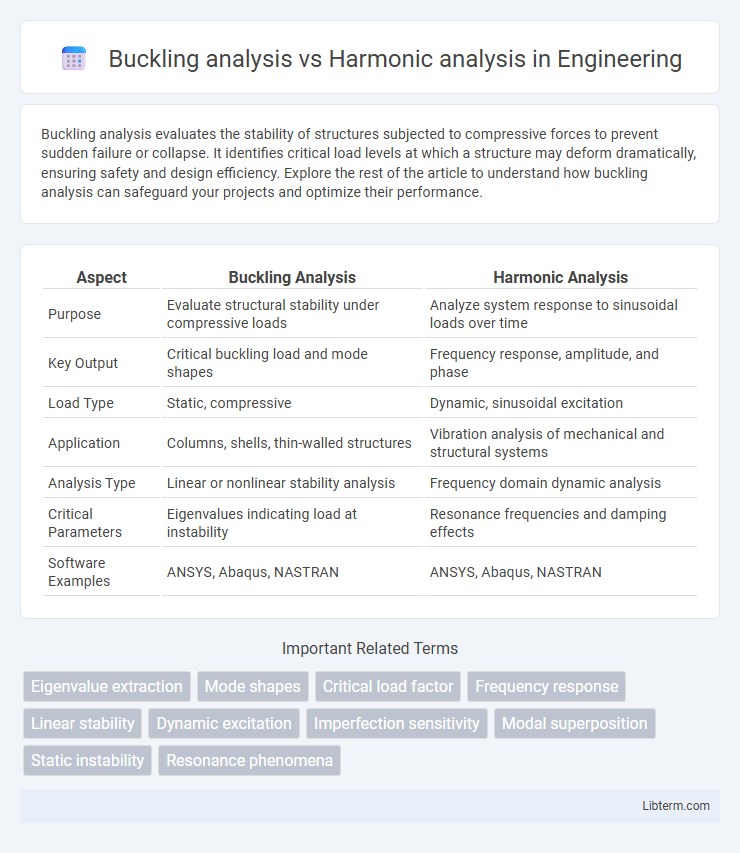Buckling analysis evaluates the stability of structures subjected to compressive forces to prevent sudden failure or collapse. It identifies critical load levels at which a structure may deform dramatically, ensuring safety and design efficiency. Explore the rest of the article to understand how buckling analysis can safeguard your projects and optimize their performance.
Table of Comparison
| Aspect | Buckling Analysis | Harmonic Analysis |
|---|---|---|
| Purpose | Evaluate structural stability under compressive loads | Analyze system response to sinusoidal loads over time |
| Key Output | Critical buckling load and mode shapes | Frequency response, amplitude, and phase |
| Load Type | Static, compressive | Dynamic, sinusoidal excitation |
| Application | Columns, shells, thin-walled structures | Vibration analysis of mechanical and structural systems |
| Analysis Type | Linear or nonlinear stability analysis | Frequency domain dynamic analysis |
| Critical Parameters | Eigenvalues indicating load at instability | Resonance frequencies and damping effects |
| Software Examples | ANSYS, Abaqus, NASTRAN | ANSYS, Abaqus, NASTRAN |
Introduction to Structural Analysis Methods
Buckling analysis evaluates a structure's stability under compressive loads by predicting the critical load at which it loses stability, preventing sudden failure. Harmonic analysis assesses the dynamic response of structures to sinusoidal loads, identifying resonant frequencies and vibration amplitudes critical for fatigue life and structural integrity. Both methods are foundational in structural analysis, enabling engineers to design safer and more reliable systems by addressing static instability and dynamic excitation challenges.
Overview of Buckling Analysis
Buckling analysis evaluates the critical load at which a structure becomes unstable and experiences sudden deformation, crucial for ensuring safety in slender elements under compressive forces. It predicts failure modes by calculating buckling load factors and modes using eigenvalue or linear perturbation methods. This analysis is essential in designing columns, shells, and frames to prevent catastrophic collapse due to buckling under static or quasi-static loading conditions.
Fundamentals of Harmonic Analysis
Harmonic analysis evaluates the steady-state response of structures under sinusoidal dynamic loading, focusing on frequency-dependent behavior and resonance phenomena. It determines the amplitude and phase of displacements, stresses, and strains at various excitation frequencies, essential for predicting vibrational performance and avoiding structural failure. Unlike buckling analysis, which assesses critical load factors for stability under static conditions, harmonic analysis addresses dynamic loading effects by solving equations of motion in the frequency domain.
Key Differences Between Buckling and Harmonic Analysis
Buckling analysis examines the critical load at which a structure becomes unstable, focusing on the deformation or collapse risk under compressive stresses, while harmonic analysis evaluates the steady-state response of structures subjected to sinusoidal or periodic loading over a range of frequencies. Buckling analysis primarily deals with static, nonlinear stability issues, whereas harmonic analysis addresses dynamic behavior by calculating natural frequencies, mode shapes, and resonance effects. The key difference lies in buckling analysis predicting failure due to instability, and harmonic analysis assessing vibration amplitude and stress caused by oscillatory forces.
Typical Applications of Buckling Analysis
Buckling analysis is typically applied in structural engineering to predict critical load levels that cause sudden failure in columns, beams, and thin-walled structures under compressive stress. This analysis is essential for designing aerospace components, bridges, and automotive chassis to ensure stability and prevent catastrophic collapse. Unlike harmonic analysis, which evaluates dynamic response to periodic loads, buckling analysis specifically addresses stability under static or slowly varying compressive forces.
Common Uses of Harmonic Analysis
Harmonic analysis is commonly used to evaluate the steady-state response of structures or mechanical components under sinusoidal dynamic loads, such as vibrations in rotating machinery or electronic devices. It helps predict resonance frequencies and amplitude magnifications to prevent structural failure and optimize design for durability. Unlike buckling analysis, which assesses stability under compressive loads, harmonic analysis focuses on dynamic performance and fatigue life under oscillatory forces.
Critical Parameters Influencing Buckling and Harmonic Results
Critical parameters influencing buckling analysis include material properties like Young's modulus and Poisson's ratio, geometric imperfection scale, boundary conditions, and applied compressive loads. In harmonic analysis, key factors are the excitation frequency spectrum, damping coefficients, and system stiffness, directly affecting resonance amplitudes and vibration modes. Accurate modeling of these parameters ensures reliable prediction of structural stability under buckling and dynamic response in harmonic loading scenarios.
Software Tools for Buckling and Harmonic Analysis
ANSYS and Abaqus are leading software tools widely used for buckling and harmonic analysis due to their advanced simulation capabilities and extensive material libraries. These platforms enable engineers to predict structural instability under critical loads and analyze dynamic response to harmonic excitation with high precision. Their integrated finite element methods support complex geometries and loading conditions, optimizing design safety and performance.
Challenges and Limitations in Each Analysis Type
Buckling analysis faces challenges in accurately predicting instability under nonlinear material behavior and geometric imperfections, often requiring extensive computational resources for large-scale structures. Harmonic analysis is limited by assumptions of linearity and steady-state conditions, which restrict its effectiveness in capturing real-world transient or nonlinear dynamic responses. Both analyses demand precise input parameters and boundary conditions to avoid errors, with buckling analysis sensitive to initial stress states and harmonic analysis constrained by frequency resolution and damping modeling.
Conclusion: Selecting the Right Analysis Method
Selecting the right analysis method depends on the specific engineering problem. Buckling analysis is essential for evaluating structural stability under compressive loads and predicting failure due to instability, while harmonic analysis is best suited for understanding the response of structures to dynamic, time-varying loads such as vibrations or oscillations. Engineers must assess load conditions and failure modes to choose between buckling analysis for critical load assessment or harmonic analysis for frequency response evaluation.
Buckling analysis Infographic

 libterm.com
libterm.com